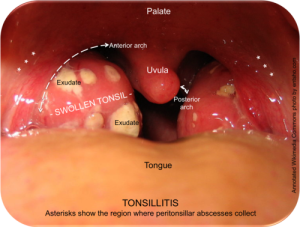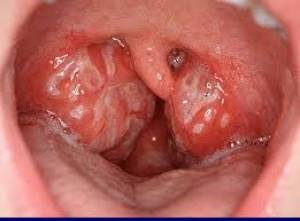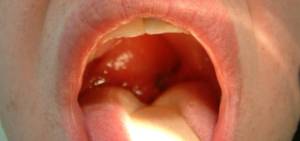Oro-pharyngeal infections
Peritonsillar Abscess (Quinsy)
- the most common deep head and neck infection that affects patients of all ages
- favoured treatment is antibiotic therapy combined with abscess drainage.
- Abscess drainage takes the form of needle aspiration, intra-oral incision and drainage, or quinsy tonsillectomy.
- indications for abscess tonsillectomy became controversial over the past years due to increased risk of spread of infection and postoperative tonsillar bed bleeding
Typical presentation:
- Sore throat -worse on 1 side
- Fever
- 'Thick' or 'hot potato' voice (not hoarse, croaky voice)
- Stertor
- Trismus
- Inability to swallow more than saliva or a sip or water
Diagnosed as Triad:
- Trismus
- Uvula deviation
- dysphonia - 'hot potato voice'
- Peritonsillar cellulitis is a variation on the theme of a true abscess, but the cellulitic phase is easy to confuse with a true abscess
- true adult peritonsillar abscess usually will not resolve without some type of surgical drainage procedure, peritonsillar cellulitis is much more likely to respond to antibiotics alone
- dysphagia and drooling tend to be discriminators for an abscess, and trismus is more common in cellulitis but patients presenting with either process have quite similar clinical scenarios.
Management
- Bacteria involved include Strep Grp A, Viridans Strep, Fusobacterium necrophorum (anaerobe) amongst many others, therefore antibiotic choice varies
- antibiotic Rx - usually Penicillin based but beware Amoxycillin as illness may be EBV. Choices include:
- Amoxicillin/clavulanic acid 875mg BID x 10 days
- Penicillin VK 500mg QID + Metronidazole 500mg QID x 10 days
- PCN Allergy: Clindamycin 150mg QID x 10 days
- dexamethasone 6mg recommended by some
- analgesia - paracetamol, NSAIDs
- surgical Rx - needle drainage, formal incision & drainage
Several scoring systems have been proposed to aid Mx:
Novel PTA score | Points |
|---|---|
| Halitosis | 1 |
| Uvula oedema | 1 |
| Unilat swelling of arched palate | 1 |
| Trismus | 1 |
| S100A8/A9 serum >2550ng/ml | 1 |
| S100A8/A9 saliva >8180ng/ml | 1 |
| Score ≤2: Primary medical Rx Score >2: surgical Rx S100A8/A9 are myeloid related proteins |
Liverpool Peritonsillar Abscess Score (LPS) | Points |
|---|---|
| Unilateral sore throat | 3 |
| Trismus | 2 |
| Male gender | 1 |
| Pharyngeal voice change | 1 |
| Uvular deviation | 1 |
| Score <4: unlikely to have PTA |
Ludwig's Angina
- Ludwig's angina usually originates as a dental infection of the second or third mandibular molars, including partially erupted third molars.
- infection initially spreads to the sublingual space and progresses to the submandibular space.
- usually polymicrobial involving oral flora, both aerobes and anaerobes.
- most commonly:
- neck swelling, neck pain - “bull neck,” with increased fullness of the submental area and loss of mandibular angle definition
- trismus
- odynophagia, dysarthria, dysphagia - increased tongue prominence indicates sublingual space involvement.
- Fever and chills are common.
- Stridor indicates impending airway obstruction
- typically NO lymphadenopathy. The presence of crepitus should raise suspicion for other pathologies, such as necrotizing fasciitis.
Differential
- peritonsillar abscess, retropharyngeal abscess, submandibular abscess, epiglottitis, oral carcinoma, angioedema, submandibular hematoma, and diphtheria.
References include:
Novel PTA score 2018
Liverpool PTA score dev
Differentiating Peritonsillar abscess and cellulitis 2018
Complications of PTA - Annals of Micro 2020
https://journals.lww.com/em-news/fulltext/2001/02000/emergency_department_approach_to_peritonsillar.15.aspx
https://coreem.net/core/peritonsillar-abscess/
https://www.statpearls.com/kb/viewarticle/24447/?utm_source=TrendMD&utm_campaign=StatPearls_TrendMD_0&utm_medium=cpcStat Pearls - Ludwig's angina


